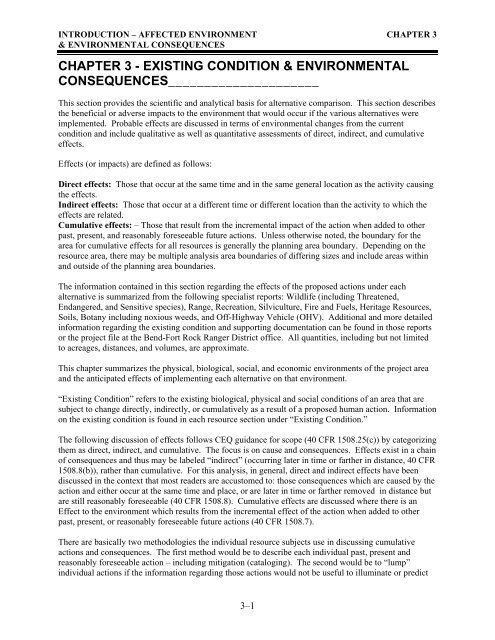Environmental Assessment
Environmental Assessment
Environmental Assessment
Create successful ePaper yourself
Turn your PDF publications into a flip-book with our unique Google optimized e-Paper software.
INTRODUCTION – AFFECTED ENVIRONMENT CHAPTER 3<br />
& ENVIRONMENTAL CONSEQUENCES<br />
CHAPTER 3 - EXISTING CONDITION & ENVIRONMENTAL<br />
CONSEQUENCES_____________________<br />
This section provides the scientific and analytical basis for alternative comparison. This section describes<br />
the beneficial or adverse impacts to the environment that would occur if the various alternatives were<br />
implemented. Probable effects are discussed in terms of environmental changes from the current<br />
condition and include qualitative as well as quantitative assessments of direct, indirect, and cumulative<br />
effects.<br />
Effects (or impacts) are defined as follows:<br />
Direct effects: Those that occur at the same time and in the same general location as the activity causing<br />
the effects.<br />
Indirect effects: Those that occur at a different time or different location than the activity to which the<br />
effects are related.<br />
Cumulative effects: – Those that result from the incremental impact of the action when added to other<br />
past, present, and reasonably foreseeable future actions. Unless otherwise noted, the boundary for the<br />
area for cumulative effects for all resources is generally the planning area boundary. Depending on the<br />
resource area, there may be multiple analysis area boundaries of differing sizes and include areas within<br />
and outside of the planning area boundaries.<br />
The information contained in this section regarding the effects of the proposed actions under each<br />
alternative is summarized from the following specialist reports: Wildlife (including Threatened,<br />
Endangered, and Sensitive species), Range, Recreation, Silviculture, Fire and Fuels, Heritage Resources,<br />
Soils, Botany including noxious weeds, and Off-Highway Vehicle (OHV). Additional and more detailed<br />
information regarding the existing condition and supporting documentation can be found in those reports<br />
or the project file at the Bend-Fort Rock Ranger District office. All quantities, including but not limited<br />
to acreages, distances, and volumes, are approximate.<br />
This chapter summarizes the physical, biological, social, and economic environments of the project area<br />
and the anticipated effects of implementing each alternative on that environment.<br />
“Existing Condition” refers to the existing biological, physical and social conditions of an area that are<br />
subject to change directly, indirectly, or cumulatively as a result of a proposed human action. Information<br />
on the existing condition is found in each resource section under “Existing Condition.”<br />
The following discussion of effects follows CEQ guidance for scope (40 CFR 1508.25(c)) by categorizing<br />
them as direct, indirect, and cumulative. The focus is on cause and consequences. Effects exist in a chain<br />
of consequences and thus may be labeled “indirect” (occurring later in time or farther in distance, 40 CFR<br />
1508.8(b)), rather than cumulative. For this analysis, in general, direct and indirect effects have been<br />
discussed in the context that most readers are accustomed to: those consequences which are caused by the<br />
action and either occur at the same time and place, or are later in time or farther removed in distance but<br />
are still reasonably foreseeable (40 CFR 1508.8). Cumulative effects are discussed where there is an<br />
Effect to the environment which results from the incremental effect of the action when added to other<br />
past, present, or reasonably foreseeable future actions (40 CFR 1508.7).<br />
There are basically two methodologies the individual resource subjects use in discussing cumulative<br />
actions and consequences. The first method would be to describe each individual past, present and<br />
reasonably foreseeable action – including mitigation (cataloging). The second would be to “lump”<br />
individual actions if the information regarding those actions would not be useful to illuminate or predict<br />
3–1
















